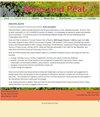基于Drentsche Aa brook山谷重新湿润后植被变化的温室气体减排估算
IF 1.5
4区 环境科学与生态学
Q4 ENVIRONMENTAL SCIENCES
引用次数: 2
摘要
重新湿润可以有效地减少泥炭地的温室气体排放。需要可靠的排放量估计方法来核算这种减排并评估碳信用的潜力。年平均水位和植被是排放估算的可靠且广泛使用的指标。然而,基于植物物种的水位指示(如艾伦伯格指示值)是定性的,差异很大,并且没有足够的高质量通量测量数据来支持直接使用植被作为温室气体通量的代表。在这里,我们将植被和水位指标结合起来,通过使用植被群落的水位生物指示以及年平均水位和GHG通量之间的线性相关性来估计排放量。这种方法在荷兰的Drentsche Aa brook山谷得到了证明,那里的泥炭地被重新湿润,以恢复丰富的沼泽植被。通过在重新湿润前后反复绘制植被图来监测景观的生物多样性,这使得能够估计减排是一项共同利益。使用相应植物群落测量的水位动态现有数据,将年平均水位值分配给绘制的植被类型。温室气体排放量是使用气体通量与年平均水位的线性回归模型估计的。这种方法提供了对年平均水位和温室气体通量的空间显式和定量估计。当与空间模式和方差信息相结合时,由此产生的估计可以促进对生物多样性恢复的碳共益的认识,同时促进管理实践的更具体的优化。本文章由计算机程序翻译,如有差异,请以英文原文为准。
Estimation of greenhouse gas emission reductions based on vegetation changes after rewetting in Drentsche Aa brook valley
Rewetting can effectively reduce greenhouse gas (GHG) emissions from drained peatlands. Reliable emissions estimation approaches are needed for accounting of such reductions and for evaluating the potential in terms of carbon credits. Annual mean water level and vegetation are reliable and widely used proxies for emissions estimation. However, indications of water level based on plant species (e.g. Ellenberg Indicator Values) are qualitative with large variances, and there are insufficient high-quality flux measurement data to support the direct use of vegetation as a proxy for GHG fluxes. Here we combine vegetation and water level proxies to estimate emissions, by using bioindication of vegetation communities for water level together with the linear correlation between annual mean water level and GHG fluxes. This approach is demonstrated in the Drentsche Aa brook valley in The Netherlands, where peatlands were rewetted to restore rich fen vegetation. Biodiversity of the landscape was monitored by repeated vegetation mapping before and after rewetting, which enables the estimation of emissions reduction as a co-benefit. Mean annual water level values are assigned to mapped vegetation types using existing data on water level dynamics from measurements on corresponding plant communities. GHG emissions are estimated using linear regression models of gas fluxes against mean annual water levels. This approach provides spatially explicit and quantitative estimation of mean annual water levels and GHG fluxes. When combined with information on spatial patterns and variances, the resulting estimations can promote recognition of the carbon co-benefits of biodiversity restoration while facilitating more site-specific optimisation of management practices.
求助全文
通过发布文献求助,成功后即可免费获取论文全文。
去求助
来源期刊

Mires and Peat
ENVIRONMENTAL SCIENCES-
CiteScore
2.30
自引率
16.70%
发文量
0
审稿时长
33 weeks
期刊介绍:
Mires and Peat is a peer-reviewed internet journal focusing specifically on mires, peatlands and peat. As a truly “free-to-users” publication (i.e. NO CHARGES to authors OR readers), it is immediately accessible to readers and potential authors worldwide. It is published jointly by the International Peatland Society (IPS) and the International Mire Conservation Group (IMCG).
Mires and Peat is indexed by Thomson Reuters Web of Science (2017 Impact Factors: 1.326 [two-year] and 1.638 [five-year]), Elsevier Scopus, EBSCO Environment Complete, CABI Abstracts, CSA Proquest (including their Aquatic Science and Fisheries Abstracts ASFA, Ecology, Entomology, Animal Behavior, Aqualine and Pollution databases) and Directory of Open Access Journals (DOAJ). Mires and Peat also participates in the CABI Full Text Repository, and subscribes to the Portico E-journal Preservation Service (LTPA).
Mires and Peat publishes high-quality research papers on all aspects of peatland science, technology and wise use, including:
ecology, hydrology, survey, inventory, classification, functions and values of mires and peatlands;
scientific, economic and human aspects of the management of peatlands for agriculture, forestry, nature conservation, environmental protection, peat extraction, industrial development and other purposes;
biological, physical and chemical characteristics of peat; and
climate change and peatlands.
Short communications and review articles on these and related topics will also be considered; and suggestions for special issues of the Journal based on the proceedings of conferences, seminars, symposia and workshops will be welcomed. The submission of material by authors and from countries whose work would otherwise be inaccessible to the international community is particularly encouraged.
 求助内容:
求助内容: 应助结果提醒方式:
应助结果提醒方式:


